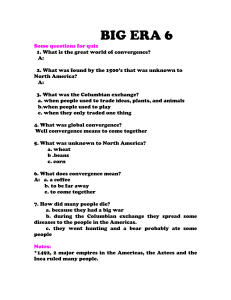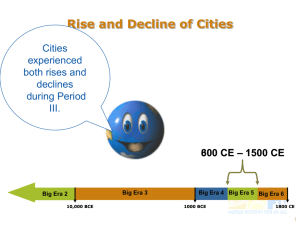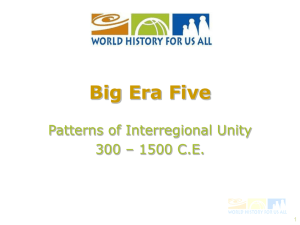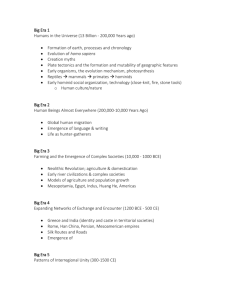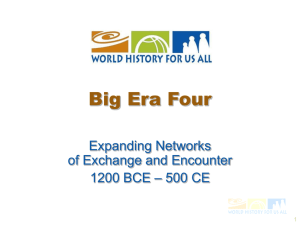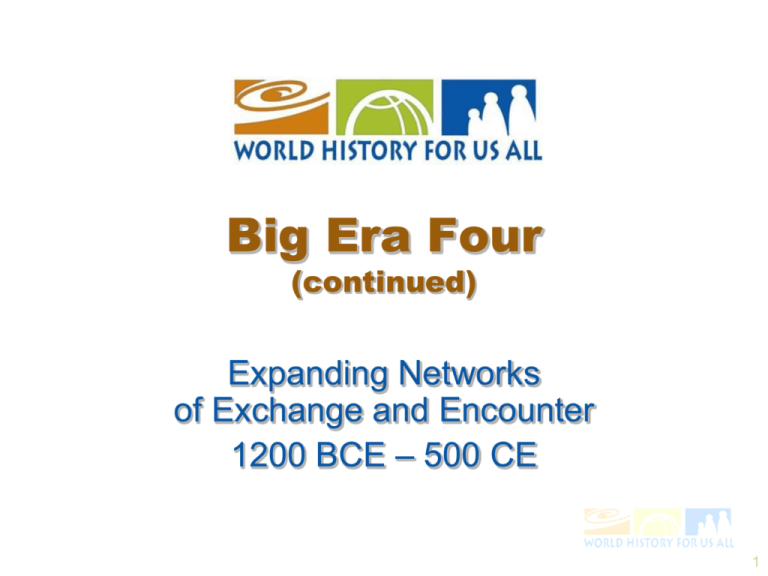
Big Era Four
(continued)
Expanding Networks
of Exchange and Encounter
1200 BCE – 500 CE
1
Population Growth
In Summary:
In Afroeurasia, the invention of
iron enabled farmers to clear and
cultivate millions of acres never
before used for farming.
Farming and pastoral nomadism
replaced hunting and gathering
in some regions. People moved
into previously uninhabited
areas.
Improved kinds of crops produced more food per acre.
Horses and camels began to be used more as work animals, making farms more
productive.
People began to live closer in denser populations. This led to the build-up of
natural immunities to local infectious diseases but left people vulnerable to
epidemics caused by diseases new to the region.
2
Population Growth
In Summary:
Over time, deforestation led to
soil erosion, shortages of wood
for fuel, and the extinction of
some local animal and plant
species.
Brahmin
Kshatriya
Vaishya
Sudra
When communities grew larger,
more complex, and closer
together, new political, social,
and economic systems became
necessary.
Untouchable
Collective learning increased, further fueling advances in technology.
Although the vast majority of people still inhabited rural farming villages, more
people than ever before began living in large cities.
3
Expanding Networks
Routes
Around 300 BCE to 300 CE, merchants,
shippers, sea captains, and empire-builders
extended and strengthened trade routes
across Afroeurasia and the Americas.
Empires
Empires required networks of military and
political communication. These networks
encouraged interaction of many kinds over
long distances.
Writing
With the appearance of alphabetic writing
systems in Afroeurasia, people could
communicate faster and easier than ever
before.
Religions
The appearance of world religions—
Hinduism, Judaism, Buddhism, and
Christianity—stimulated cultural interchange
across political and cultural boundaries.
4
Expanding Networks:
Routes
In the Americas...
The Olmec of Mexico developed extensive trade
networks that extended hundreds of miles from
Olmec territory. They imported jade and other raw
materials for their crafts. Their exports included
pottery and sculpture.
The Tiwanakans in what is today Bolivia also
began to build trade routes during Big Era
Four. Llama caravans brought produce,
wood, metals, and fish from outlying villages
to the city of Tiwanaku.
5
Expanding Networks:
Routes
The silk road,
Persian royal road,
Roman roads, and
shipping routes
combined to form
extensive
interregional
networks of
exchange in
Afroeurasia.
A wide variety of goods
flowed along these
networks…
6
Expanding Networks:
Routes
Sea routes ran down the
Red Sea and Persian Gulf,
across the Arabian Sea and
Bay of Bengal, and through
the Straits of Malacca to the
South China Sea.
These sea lanes often linked
up with overland routes,
facilitating travel, trade, and
the exchange of ideas
across Afroeurasia.
Roman
Ship
Indian
Ship
Chinese
Ship
7
Expanding Networks:
Empires
Empires had formed in Afroeurasia as
early as Big Era Three. Although many
claimed vast territories, most did not
survive for long.
In the 4th century BCE, Alexander the
Great amassed an empire that stretched
from Greece to India. Upon his death,
however, the empire fragmented.
The later centuries of Big Era Four saw
the rise of new empires that both
dominated huge expanses of land and
remained unified for a long time. The
Largest of these were the Han and
Roman empires.
8
Expanding Networks:
Writing
Cool!
• Alphabetic writing systems appeared
in the later second millennium BCE.
These systems used a small number
of symbols, or letters, to represent
sounds.
• Letters could be arranged in countless
ways to form words.
• The Phoenicians were among the first to devise an alphabet.
• Because they were sailors and merchants, the idea of alphabetic
writing spread wherever the Phoenicians traveled.
• During the first millennium BCE alphabetic writing spread from the
Mediterranean region to India.
9
Expanding Networks:
Religions
What is a world religion?
It’s a belief system that
embraces people of
differing languages and
cultural traditions.
Religions that spread
during Big Era Four were:
Hinduism
Judaism
Buddhism
Christianity
10
Population
Growth
Population growth in Big Era
Four was linked to the
expansion of agriculture.
Increases in population density
and job specialization in
farming communities led to the
creation of more and larger
cities.
Expanded networks of exchange
allowed people, goods, and ideas
to move thousands of miles. The
development of alphabetic writing
systems speeded up the transfer
of information. Also, people who
met, shared ideas, and conducted
business with one another helped
spread new world religions across
Afroeurasia.
Expanding Networks
of Exchange
11
Big Era Five
Patterns of Interregional Unity
300 – 1500 C.E.
12
Patterns of Interregional Unity
Big Era Five
lasted from 300
CE to 1500 CE.
Welcome to
Big Era
Five!
300 CE – 1500 CE
Big Era 2
10,000 BCE
Big Era 3
Big Era 4 Big Era 5 Big Era 6
1000 BCE
1800 CE
13
Microsoft®Encarta®Reference Library 2002. ©1993-2001 Microsoft Corporation. All rights reserved.
During Big Era Five, many connections
were established among regions. These
formed interregional patterns of unity.
14
At the start of Big Era
Five, numerous
inventions, trade goods,
ideas, and religions
were starting to spread
from their regions of
origin.
15
By the end of Big Era
Five, many of these
important ideas and useful
things had spread all
across Afroeurasia…
…That spread of
ideas and things is
part of cultural
exchange.
16
Cultural exchange had many aspects.
Population increased
and people migrated.
People shared ideas
across regions.
Trade networks expanded
and cities grew.
Huge empires brought many
different groups of people
together.
17
Population
World
population
grew from
about
250 million to
460 million
between
200 CE
and 1500 CE.
18
500
Population
450
400
350
300
250
The
population
of the
Americas
was much
smaller than
the
population
of
Afroeurasia.
World Population
200
150
100
50
American Population
0
3rd 4th 5th 6th 7th 8th 9th 10th 11th 12th 13th 14th 15th 16th
c. c. c.
19
Population growth in Afroeurasia
affected the environment.
Population
Deforestation happened when
cities and farming expanded.
20
Population
Human impact on the
environment had serious
effects!
• Wood was
insufficient for heat,
construction, and
metal-working.
• Soil eroded and
degraded.
• River flooding
devastated villages,
farmlands, and
cities.
• Famines meant
people didn’t get
enough to eat.
21
Vikings
Population
Mongols
Germanic
Tribes
Turkic
Groups
Chinese
Arabs
Bantu-Speaking
People of Africa
People of
Oceania
People migrated to new
places in (and out) of
Afroeurasia.
22
Population
• Migrating groups moved
into other groups’
territories, forcing them
to go elsewhere.
Migrations
encouraged more
cultural exchanges
across Afroeurasia.
• Migrating groups
introduced new plants
and animals into their
new homes.
• Migrations diffused
technologies for farming,
warfare, and crafts.
• Migrations diffused
languages, styles of
living, and arts.
23
Empires
Building states and
empires involved
cultural exchanges in
Afroeurasia.
During Big Era Five,
many, many states
and empires came…
and went.
24
Empires
New ruling groups
built on the
foundations of
earlier states and
empires.
25
Frankish
Kingdoms
Avar Kingdom
Parhae
Byzantine Empire
Sassanid
Empire
Sui China
Silla
Yamoto
Japan
Harsha’ Empire
Chalukya
Ghana
Axum
States and Empires in 600 CE
26
Carolingian
Parhae
Byzantine
Cordoba
Caliphate
Abbasid
Caliphate
GurjaraPratihara
Tang China
Silla
Heian
Japan
Ghana
Axum
Srivijaya
States and Empires in 800 CE
27
Scandanavian
Kingdoms
Russia
England
France
Spain
H.R.E.
Poland
Mongol Empire
Hungary
Rum
Portugal Almohad
Caliphate Ayyubid
Caliphate
Koryo
Delhi
Sultanate
Sung
China
Kamakura
Japan
Mali
Ethiopia
Oyo
Angkor
Benin
Zimbabwe
States and Empires in 1237 CE
28
Union of Kalmar
Russian
States
Scotland
England
France
Portugal
PolandKhanate of the
Holy
Lithuania Golden Horde
Roman
Empire Hungary
Castile
Jagatai
Khanate
Ottoman Emp.
Timurid Empire
Granada
Marinids Hafsids
Korea
Ming
China
Ashikaga
Japan
Mamluk
Sultanate
Mali
Oyo Benin
Ethiopia
Vijayanagara
Zanj City-States
Siam
Majapahit
Zimbabwe
States and Empires in 1400 CE
29
Empires
How did states
and empires
stimulate cultural
exchanges in
Afroeurasia?
• Wars led to
destruction but
produced new
inventions.
• Strong governments
protected trade
routes and stabilized
currencies.
• Royal courts were
patrons of science,
religious institutions,
and arts.
• Large states brought
together many
ethnic, language, and
religious groups.
30
Trade
Trade was also
closely linked to
cultural exchange.
Empires supported
trade in
Afroeurasia.
Merchants traveled
great distances in
search of wealth.
31
Trade
The number of cities grew, as
well as trade networks between
them.
32
Trade
Microsoft®Encarta®Reference Library 2002. ©1993-2001 Microsoft Corporation. All rights reserved.
From 300-1500 CE, trade routes extended
farther and were used by more travelers.
33
• Trade helped spread
religions, languages,
ideas, and arts.
Trade
How did expanding trade
networks bring about
cultural exchanges in
Afroeurasia?
• Trade stimulated
use of natural
resources.
• Cities and
manufacturing
centers grew bigger.
• Banks, credit, and
money systems
encouraged regional
and long distance
trade.
34
Ideas
During Big Era
Five, universal
religions spread
across Afroeurasia.
Universal religions
are belief systems
that anyone can join
– they’re not limited
to any one group.
35
Ideas
Buddhism
Christianity
Hinduism
Islam
The spread of universal religions
from 300-1500 CE
36
Who spread these universal
religions across Afroeurasia?
Ideas
Monks spread
Buddhism.
Traders and Sufi
orders spread
Islam.
Missionaries
spread
Christianity.
37
How did the
spread of religion
encourage
cultural exchange
in Afroeurasia?
Ideas
• Universal faiths gave
members a sense of
community beyond
political, class, or
ethnic identities.
• Religious scholars
gathered and recorded
knowledge and founded
institutions of learning.
• The spread of religions
stimulated production
and exchange of arts,
literature, philosophy,
and the sciences.
38
Ideas
What inventions,
technologies,
products, and ideas
were exchanged
across Afroeurasia?
39
Scholars studied and spread
knowledge in many institutions
of learning.
Ideas
Sung
scholar
Korean
library
European
astronomer
Muslim
astronomer
s
40
Natural sciences developed in
many places.
Ideas
Chinese
Muslim
Indian
European
41
Transport and communication
technologies improved.
Ideas
Sternrudder
Lateen sail
Books & paper
North Arabian
camel saddle
Stirrup
Mapmakin
g
Astrolabe
42
Water & energy technologies were
transferred across Afroeurasia.
Ideas
• Hydraulic systems
carried water where
expanding cities
needed it.
• Wheels lifted water
to irrigate crops and
drain swamps.
• Waterwheels,
windmills, and triphammers provided
energy for pumping,
grinding, milling, and
pounding.
43
Ideas
Crops also diffused across
Afroeurasia. Travelers and
migrants introduced plants into
new regions. People began to
grow, eat, and sell these crops.
44
Ideas
• Sorghum fattened up
folks when this cereal
crop spread from eastern
Africa to China.
• Citrus fruits rolled from
Southwest Asia to Spain,
celebrated in garden and
song.
• Cane sugar sweetened a
path from India to the
Mediterranean.
• Cotton wove its way from
India to North Africa,
Central Asia, and China.
• Veggies like spinach,
asparagus, and broccoli
stirred vitamins into
meals across the
hemisphere.
45
Ideas
• The pace of innovation
increased.
• Knowledge
accumulated more
quickly.
• Manufacturing and
farming productivity
increased.
• People’s diets and
health improved.
• Sea travel and
transport webs became
thicker.
How did transfers of
technology and products
change people’s lives in
Afroeurasia?
46
If you had to put
the changes in
Big Era Five into
one sentence,
what would it be?
You might say
that by 1500 CE
the world was
connected, right?
But wait! You still haven’t said much
about the Americas!
47
Well…the Americas
and Afroeurasia
were not yet
permanently linked
together.
…not until 1492 . .
.
When Columbus
set sail across the
Atlantic . . .
Microsoft®Encarta®Reference Library 2002.
©1993-2001 Microsoft Corporation. All rights reserved.
48
The Americas had fewer people
than Afroeurasia, and the two
land masses were geographically
isolated from each other.
Developments in the two regions
were similar in some ways and
different in others. In any case,
the Americas were also a region
of active human interchange.
Microsoft®Encarta®Reference Library 2002.
©1993-2001 Microsoft Corporation. All rights reserved.
49
Cultural development and exchange in the
Americas:
The Maya, Inca, and Aztec Empires
• Sciences like
astronomy,
mathematics and
engineering were
developed.
• Trade routes connected
regions.
Mississippian Mica
Moche Ceramic
• Mining, irrigation, and
agricultural
technologies
developed.
• Crops like potatoes,
maize, tomatoes,
cotton, and chocolate
were grown.
Mayan Calendar
Inca Gold
Corn & Potatoes
50
States and
Empires in the
Americas in
1500 CE
Aztec Empire
Mayan States
Inca Empire
Microsoft®Encarta®Reference Library 2002.
©1993-2001 Microsoft Corporation. All rights reserved.
51
At the very end of
Big Era Five,
European mariners
set out on transoceanic voyages to
the Americas.
Those voyages linked
the Americas with
Afroeurasia for the first
time since the migrations
of people over 13,000
years earlier!
It had to happen sooner or later!
52
Cultural
exchange in
Afroeurasia
before 1500 CE
made possible
the technologies
that in turn
permitted
transoceanic
voyages.
Mapmaking
Sternrudder
Lateen Sail
Compass
Is that why people
from Afroeurasia
discovered the
Americas, and not
the opposite?
53
In Big Era Six, we’ll see learn about the
explosive things that happened when
migration, empires, trade, and ideas
started moving around the entire globe.
End of Big Era Five
http://www.lvna.net/Activities/Fireworks/fireworks.html
54

